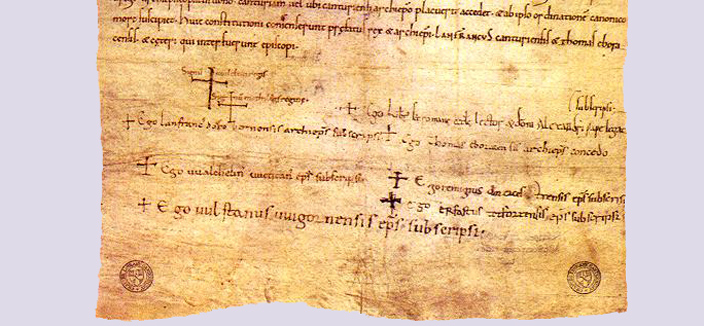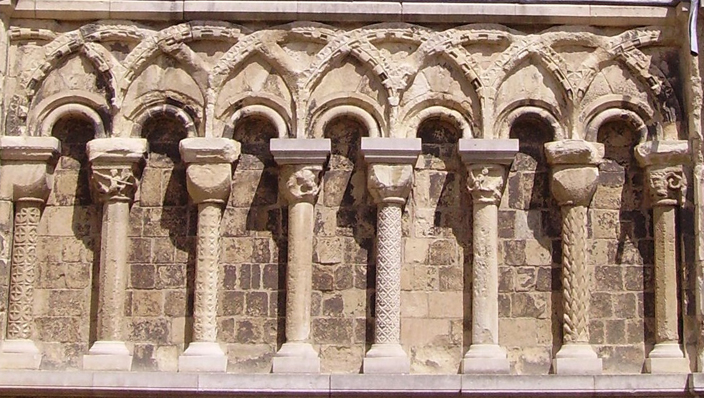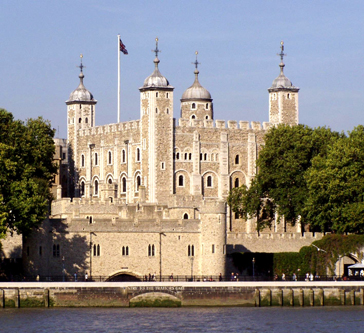The Spread of Romanesque Architecture in England
The development of Romanesque architecture in England was a result of major political change, and the aspirations of a youthful, dynamic society. Find out more.
Church Reforms in 1070
1070 marked an important date in the history of the English Church. William the Conqueror, the English king, decided to reform what was, until that point, a very Anglo-Saxon religious establishment. The archbishop of Canterbury — along with other key bishops — was deposed, and replaced by Lanfranc, the abbot of the Monastery of St Etienne (founded by William at Caen) in France.

An image of the Accord of Winchester, dating from 1072, which made the Archbishop of Canterbury the most important religious figure in England. Beside each of the crosses on the document is a signature — the top two are those of William the Conqueror and his wife Matilda; the third signature is that of Lanfranc.
Archbishop Lanfranc and his Influence
Lanfranc, one of the most renowned Benedictine monks and teachers in Europe, was not a surprising choice. His 19-year reign as archbishop led to a complete reorganisation of the English church, including the transfer of Cathedral Sees from villages to towns. This led to the rebuilding of every existing Anglo-Saxon cathedral, replacing religious complexes that had evolved over time with monumental uniform structures in the Romanesque style.

Detail of a Norman arcade at Canterbury Cathedral. The similarity to some of the stone details at Durham Cathedral is striking.
The Rebuilding of Canterbury Cathedral
Accounts of Lanfranc’s arrival in Canterbury record his complete rebuilding of the cathedral there in the span of just 5-7 years. Although Canterbury Cathedral has since been extensively remodelled, numerous fragments of Lanfranc’s Norman building remain. These remains are massive, illustrating the new Norman building technology for the construction of large-scale structures — not just cathedrals, but also military architecture, essential for the flourishing of Norman power.

The famous White Tower at the Tower of London, constructed by Gundulf, who had an important influence on the introduction of Norman architectural ideas to England. The tower was constructed of stone imported from Caen in Normandy, indicating just how strong the links to the Norman homeland were in the years immediately following William's Conquest of England.
Find out more about the Tower of London.
Gundulf the Architect
Historic records mention that when Lanfranc moved from the monastery of St Etienne in Caen to Canterbury, he brought with him a personal assistant, Gundulf, the former Prior at St Etienne. Gundulf was described as being ‘very competent and skilled at building’ and is likely to have supervised the construction of the monastery in Caen, and then the rebuilding of Canterbury Cathedral. Historic accounts tell us that he also supervised the construction of a castle at Rochester, the rebuilding of the cathedral there, and the building of the White Tower at the Tower of London.
Architectural Patronage and the Spread of Ideas
The enthusiasm of a young people is often expressed through the colossal and the immoderate. It was a youthful Egypt which erected the Great Pyramid during the first dynasties; it was the youthful United States which attempted to beat world records and which built ever taller skyscrapers ... Young medieval society, symbolised by the bourgeoisie, was gripped by the 'world record fever' and built its naves closer and closer to heaven.
Jean Gimpel, The Cathedral Builders, p32.
The spread of Romanesque architecture in Britain must be seen in the context of a youthful Anglo-Norman society, at least partially inspired by Normandy but also by its new English setting.
The reorganisation of the church leading to a wave of cathedral building provided the perfect environment for new ideas to flourish. There was also competition between Cathedral Sees, each one wanting the biggest, the highest, and the best building.

